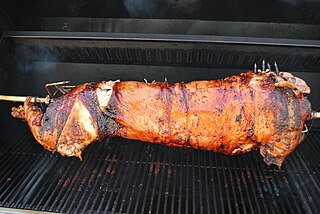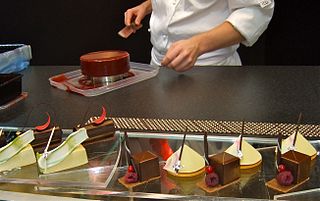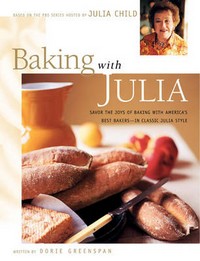
Baking is a method of preparing food that uses dry heat, typically in an oven, but can also be done in hot ashes, or on hot stones. The most common baked item is bread, but many other types of foods can be baked. Heat is gradually transferred "from the surface of cakes, cookies, and pieces of bread to their center, typically conducted at elevated temperatures surpassing 300°F. Dry heat cooking imparts a distinctive richness to foods through the processes of caramelization and surface browning. As heat travels through, it transforms batters and doughs into baked goods and more with a firm dry crust and a softer center. Baking can be combined with grilling to produce a hybrid barbecue variant by using both methods simultaneously, or one after the other. Baking is related to barbecuing because the concept of the masonry oven is similar to that of a smoke pit.

Marinating is the process of soaking foods in a seasoned, often acidic, liquid before cooking. The origin of the word alludes to the use of brine in the pickling process, which led to the technique of adding flavor by immersion in liquid. The liquid in question, the marinade, can be either acidic or enzymatic, or have a neutral pH. In addition to these ingredients, a marinade often contains oils, herbs, and spices to further flavor the food items.

Roasting is a cooking method that uses dry heat where hot air covers the food, cooking it evenly on all sides with temperatures of at least 150 °C (300 °F) from an open flame, oven, or other heat source. Roasting can enhance the flavor through caramelization and Maillard browning on the surface of the food. Roasting uses indirect, diffused heat, and is suitable for slower cooking of meat in a larger, whole piece. Meats and most root and bulb vegetables can be roasted. Any piece of meat, especially red meat, that has been cooked in this fashion is called a roast. Meats and vegetables prepared in this way are described as "roasted", e.g., roasted chicken or roasted squash.

Pastry is baked food made with a dough of flour, water, and shortening that may be savoury or sweetened. Sweetened pastries are often described as bakers' confectionery. The word "pastries" suggests many kinds of baked products made from ingredients such as flour, sugar, milk, butter, shortening, baking powder, and eggs. Small tarts and other sweet baked products are called pastries as a synecdoche. Common pastry dishes include pies, tarts, quiches, croissants, and pasties.

A pie is a baked dish which is usually made of a pastry dough casing that contains a filling of various sweet or savoury ingredients. Sweet pies may be filled with fruit, nuts, fruit preserves, brown sugar, sweetened vegetables, or with thicker fillings based on eggs and dairy. Savoury pies may be filled with meat, eggs and cheese or a mixture of meat and vegetables.

Pirozhki are foremost, Russian baked or fried yeast-leavened boat-shaped buns with a variety of fillings. Pirozhki are a popular street food and comfort food in Eastern Europe.

A pastry chef or pâtissier is a station chef in a professional kitchen, skilled in the making of pastries, desserts, breads and other baked goods. They are employed in large hotels, bistros, restaurants, bakeries, and some cafés.

Pâté is a forcemeat. Originally, the dish was cooked in a pastry case; in more recent times it is more usually cooked without pastry in a terrine. Various ingredients are used, which may include meat from pork, poultry, fish or beef; fat, vegetables, herbs, spices, wine and brandy.

A génoise, also known as Genoese cake or Genovese cake, is a French sponge cake named after the city of Genoa and associated with French cuisine. It was created by François Massialot in the late 17th century. Instead of using chemical leavening, air is suspended in the batter during mixing to provide volume.
A brush is a device with bristles, wire or other filaments used for cleaning, grooming, painting, etc.

The following outline is provided as an overview of and topical guide to the preparation of food:

Pastilla is a meat or seafood pie in Maghrebi cuisine made with warqa dough (ورقة), which is similar to filo. It is a specialty of Morocco, Algeria, and Tunisia, where its variation is known as malsouka. It has more recently been spread by emigrants to France, Israel, and North America.

In cooking, a glaze is a glossy, translucent coating applied to the outer surface of a dish by dipping, dripping, or using a brush. Depending on its nature and intended effect, a glaze may be applied before or after cooking. It may be either sweet or savory ; typical glazes include brushed egg whites, some types of icing, and jam, and may or may not include butter, sugar, milk, oil, and fruit or fruit juice.

Sephardic Jewish cuisine is an assortment of cooking traditions that developed among the Sephardi Jews.

A meat pie is a pie with a filling of meat and often with other savory ingredients. They are found in cuisines worldwide.

Kürtőskalács is a spit cake specific to Hungarians from Transylvania, more specifically the Székelys. Originally popular in the Székely Land, it became popular in both Hungary and Romania. The first written record dates back to 1679 and was found in the village of Úzdiszentpéter, while the first recipe appears in a manuscript cookbook dated in 1781. Earlier a festive treat, now it is part of everyday consumption. A similar pastry to kürtőskalács is Baumstriezel, originating in the Transylvanian Saxon communities.

Basting is a cooking technique that involves cooking meat with either its own juices or some type of preparation such as a sauce or marinade. The meat is left to cook, then periodically coated with the juice. Basting is a technique generally known to be used for turkey, pork, chicken, duck, and beef, but may be applied to virtually any type of meat.

Baking with Julia is an American television cooking program produced by Julia Child and the name of the book which accompanied the series. Each episode featured one pastry chef or baker who demonstrates professional techniques that can be performed in a home kitchen. It was taped primarily in Child's Cambridge, Massachusetts house and was aired over four television seasons from 1997 to 1999; it is still occasionally aired in reruns on Create on PBS digital stations.

Game pie is a form of meat pie featuring game. The dish dates from Roman times when the main ingredients were wild birds and animals such as partridge, pheasant, deer, and hare. The pies reached their most elaborate form in Victorian England, with complex recipes and specialized moulds and serving dishes. Modern versions are simpler but savoury combinations of rabbit, venison, pigeon, pheasant, and other commercially available game.



















